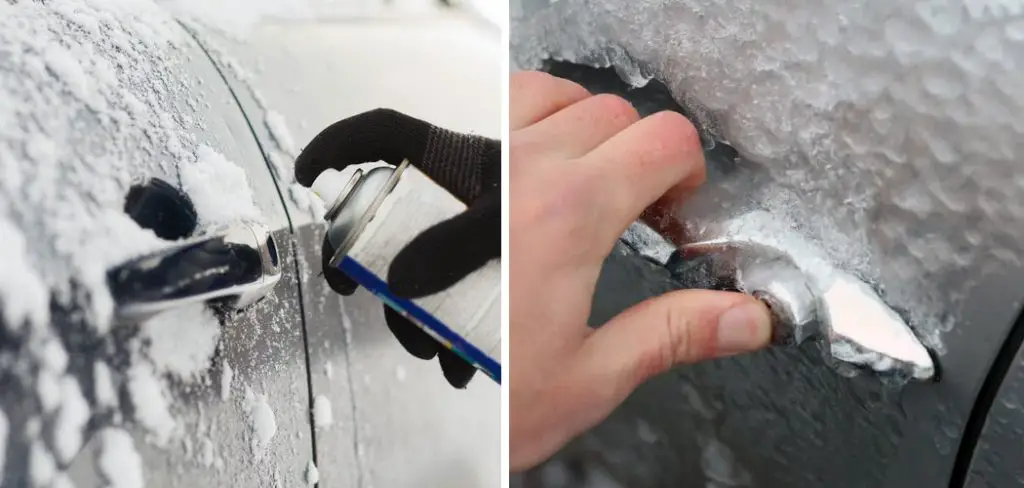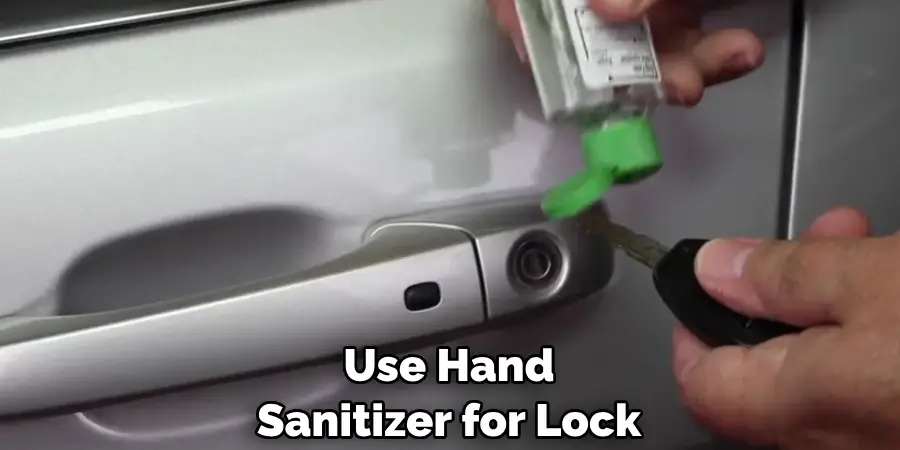Have you ever been stuck outside your car, unable to get in? This can be an unnerving and frustrating experience. Luckily, some solutions don’t involve calling a locksmith or risking damage to your vehicle by attempting to force open the door!
Car doors could get frozen due to a rapid drop in temperature, causing the moisture around the lock to freeze. This generally happens in the winter months or in colder climates. It is important to unfreeze the locks without causing any damage to the car door mechanism.

There are a few simple tricks that you can use to safely thaw the locks of your car doors and gain access to your vehicle. In this blog post, we’ll discuss some effective methods of how to unfreeze locks car doors so you can be safely back inside in no time.
What Will You Need?
Before attempting to unfreeze your car door locks, you’re going to want to make sure you have the following supplies:
- A hairdryer or heat gun for blowing hot air into the frozen lock.
- Some rubbing alcohol or de-icer solution which is specifically designed for cars.
- A cloth or rag for wiping away any excess moisture.
- Gloves to protect your hands from any cold temperatures.
Once you have your supplies ready, you can begin to unfreeze the locks of your car doors.
8 Easy Steps on How to Unfreeze Locks Car Doors
Step 1: Use Hot Air
This is the most popular method for thawing frozen car door locks. All you need is a hairdryer or heat gun and some patience. Begin by aiming the warm air from the hair dryer directly at the lock. Keep the airflow directed at the lock for several minutes, and you should soon notice that the frozen area is beginning to thaw out.
Step 2: Apply De-icer or Rubbing Alcohol
If the hot air method doesn’t work, you can use a de-icer or rubbing alcohol. These substances help lower the water’s freezing point, effectively melting the ice in the lock. To do this, pour a small amount of de-icer or rubbing alcohol into the lock.
Be careful not to pour too much, as this could flood the lock and potentially cause further issues. Once you’ve poured in the solution, wait a few moments before it takes effect before opening the lock. It’s always wise to keep a small bottle of de-icer or rubbing alcohol in your car during the colder months for situations like this.
Step 3: Use a Heated Key
If the above methods are unsuccessful, another technique involves heating your car key. Be cautious not to apply direct flame to the key, which could cause damage. Instead, heat the key by holding it under hot tap water or using a lighter carefully for a few seconds.

Wipe the key dry, then gently insert the heated key into the lock, which should help melt the ice blocking the lock mechanism. Remember to handle the hotkey carefully to avoid burning your hands.
Step 4: Lock Lubrication
After you’ve managed to thaw the lock and gain entry to your car, it’s important to remember the last step – lubrication. This is a preventative measure to avoid future freezing.
Apply a silicone-based lubricant or graphite lock lubricant into the lock. This will make the key turn smoother and prevent water from getting into the lock and freezing in the future. Be sure to wipe away any excess lubricant with a clean rag or cloth to keep the area tidy.
Step 5: Regularly Check the Condition of Your Door Seals
To prevent your car doors from freezing again in the future, it’s advisable to check the condition of your door seals regularly. If worn out or damaged, they can allow moisture to enter and freeze in the locking mechanism.
To maintain door seals, clean them regularly with a mild soap and water solution and apply a silicone-based lubricant for protection against cold and moisture.
Always ensure the seals are dry before closing the doors, especially during freezing weather. Regular maintenance will help prolong the life of the seals and keep the moisture out, reducing the chances of your car door locks freezing again.
Step 6: Use a Magnetic Heater
A magnetic heater is another method you can use to unfreeze the locks of your car doors. These heaters can be directly attached to the car door near the lock. The heat generated from the magnetic heater will gradually melt the ice, freeing your lock.
Follow the manufacturer’s instructions while using a magnetic heater to prevent any damage to the car door or the lock. This method is most effective when you have some time to spare, as thawing the lock using a magnetic heater may take a while.

Step 7: Contact a Professional
If all the methods mentioned above have been tried and the lock is still frozen, consider calling a professional locksmith. It is crucial not to force the lock as this can cause further damage. Locksmiths have specialized tools and training to handle these situations efficiently and without causing additional harm to your vehicle. Remember, it’s always better to seek professional help when in doubt.
Step 8: Prevention is Better Than Cure
Remember, it’s always easier to prevent your car door locks from freezing than to unfreeze them. One way to protect your car locks from freezing is to cover your car during snowy or icy conditions.
A good quality car cover can protect your vehicle from the elements if a garage or carport is unavailable. Ensure the cover is securely fastened to not blow away in windy conditions. Another preventive measure is regularly using a lock de-icer or a silicone-based lubricant during the cold months.
This will prevent water from getting into the lock and subsequently freezing. Finally, on particularly frosty nights, consider placing magnetic heaters on the locks before the temperature drops to prevent them from freezing.
Following these steps, you can easily unfreeze your car door locks and protect them from further damage. With regular maintenance and preventive measures, you can keep your car doors functioning smoothly all year long!
5 Additional Tips and Tricks
Tip 1: Use Hand Sanitizer: Hand sanitizer contains a high concentration of alcohol, which can effectively melt the ice. Simply dab a few drops of sanitizer on your key or directly into the lock, then gently wiggle the key until the ice melts.

Tip 2: Utilize a Straw: Use a straw to blow warm air directly into the lock if you’re in a pinch. This can help thaw the ice, especially if it’s small.
Tip 3: WD-40: WD-40 isn’t just a great lubricant; it also displaces water, which can help to unfreeze your locks. Just a small squirt directly into the lock can do the trick.
Tip 4: Heat Packs: Keeping a couple of heat packs in your car can be handy in the winter. Simply place a heat pack directly on top of the lock and wait for it to melt the ice.
Tip 5: Boiling Water: This is a last resort, but if all else fails, you can try pouring some boiling water directly into the lock to melt the ice. Be careful not to burn yourself, and always ensure the lock is completely dry before inserting your key.
Following these steps, you can easily unfreeze your car door locks without further damaging them.
5 Things You Should Avoid
1. Avoid Using Force: Never force your key to turn in a frozen lock, which can cause the key to snap or damage the lock mechanism. Patience and gentle handling are crucial when dealing with a frozen lock.
2. Avoid Leaving the Lock Wet: Always dry out your lock thoroughly after using any liquid or moisture method. Leaving the lock wet can result in the lock freezing again.
3. Avoid Neglecting Regular Maintenance: Skipping regular maintenance of your door seals and locks can lead to more frequent freezing issues. Regular cleaning and lubrication of locks can prevent a lot of problems in the future.
4. Avoid Using Hot Water Frequently: While hot water can be used as a last resort to unfreeze locks, it should not be a go-to solution. Frequent use of hot water can cause damage to the lock and lead to rusting.
5. Do Not Ignore the Signs: If your car door lock is frequently freezing, it might be a sign of a bigger problem. It’s best to pay attention to this and seek professional help immediately to prevent further damage.
Avoiding these common mistakes can help ensure your car doors stay safe and functioning all year round!

Conclusion
Ultimately, knowing how to unfreeze locks car doors is a useful skill. Understand each tool’s purpose before attempting to use it, and refer to the instructions that come with whatever you choose if needed.
Don’t forget to wear gloves when using any of these tools, as metal will quickly remove warmth from your hands in cold weather. It’s never too soon to do preventive maintenance, so make sure the locks on your vehicle are always lubricated – especially during winter–to keep them working properly.
Keeping this helpful information in mind can help ensure you don’t find yourself stuck in awkward locked door situations. Contact an expert or local auto body shop today for more tips on masterfully managing car lock emergencies!
